
Moths are a group of insects that includes all members of the order Lepidoptera that are not butterflies. They were previously classified as suborder Heterocera, but the group is paraphyletic with respect to butterflies and neither subordinate taxa are used in modern classifications. Moths make up the vast majority of the order. There are thought to be approximately 160,000 species of moth, many of which have yet to be described. Most species of moth are nocturnal, although there are also crepuscular and diurnal species.

Hibiscus syriacus is a species of flowering plant in the mallow family, Malvaceae. It is native to south-central and southeast China, but widely introduced elsewhere, including much of Asia, both in the east and the west. It was given the epithet syriacus because it had been collected from gardens in Syria. Common names include the rose of Sharon,, Syrian ketmia, shrub althea, and rose mallow. It is the national flower of South Korea and is mentioned in the South Korean national anthem.

Gracillariidae is an important family of insects in the order Lepidoptera and the principal family of leaf miners that includes several economic, horticultural or recently invasive pest species such as the horse-chestnut leaf miner, Cameraria ohridella.

Mythimna separata, the northern armyworm, oriental armyworm or rice ear-cutting caterpillar, is a moth of the family Noctuidae. It is found in China, Japan, South-east Asia, India, eastern Australia, New Zealand, and some Pacific islands. It is one of the major pests of maize in Asia. The species was first described by Francis Walker in 1865.
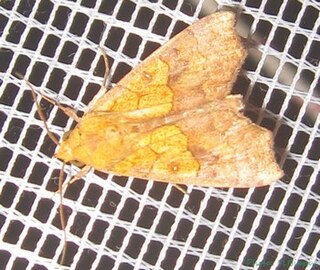
Anomis is a genus of moths in the family Erebidae.

Anomis flava, the cotton looper, tropical anomis or white-pupiled scallop moth, is a moth of the family Erebidae. The species was first described by Johan Christian Fabricius in 1775. It is found in large parts of the world, including China, Hawaii, São Tomé and Príncipe, the Society Islands, Thailand, New Zealand, and Australia. Subspecies Anomis flava fimbriago is found in North America.

Anomis erosa, the yellow scallop moth or abutilon moth, is a moth of the family Erebidae. The species was first described by Jacob Hübner in 1821. It is found in south-eastern North America. It is mostly a southern species, but migrants reach Manitoba, Quebec and Maine.

Anomis sabulifera, the angled gem or jute semi-looper, is a moth of the family Erebidae. The species was first described by Achille Guenée in 1852. It has a Paleotropical distribution and ranges from Africa eastwards to India, Sri Lanka and Australia. A single record was found from Britain.
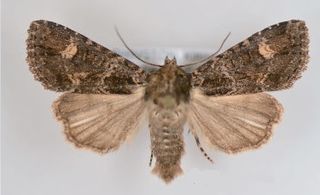
Aseptis binotata, the rusty shoulder knot moth, is a moth of the family Noctuidae. The species was first described by Francis Walker in 1865. It is found widespread in western North America, west of south-central Alberta, Wyoming, and Nebraska. Along the Pacific Coast it occurs from northern Mexico to south-central British Columbia. It can be found from sea level to altitudes over 2000 meters in a variety of habitats from dense forest to shrub desert.
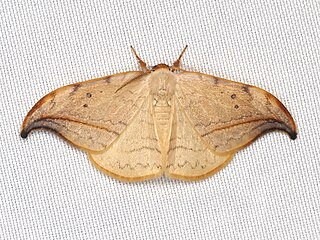
Drepana arcuata, the arched hooktip or masked birch caterpillar, is a moth of the family Drepanidae. The species was first described by Francis Walker in 1855. It is found from Newfoundland to Vancouver Island, south to at least North Carolina, South Carolina and California.
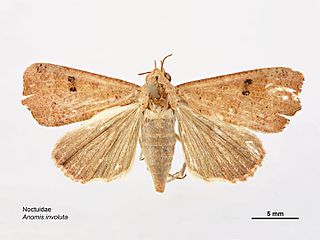
Anomis involuta, the jute looper or hibiscus cutworm, is a moth of the family Erebidae. It has a wide distribution, including the Cook Islands, Hong Kong, Japan, Korea, the Society Islands and Australia. It is also known from Kenya and Somalia.

Dumbletonius characterifer is a species of moth of the family Hepialidae. It is endemic to New Zealand. It was first described by Francis Walker in 1865.
Anomis combinans, the yellow-banded semi-looper moth, is a moth of the family Erebidae. The species was first described by Francis Walker in 1858. It is found in Australia, Sri Lanka, Borneo, New Guinea, Malaysia and Timor.
Anomis figlina is a moth of the family Erebidae first described by Arthur Gardiner Butler in 1889. It is found in Sri Lanka, India, Australia and Japan.
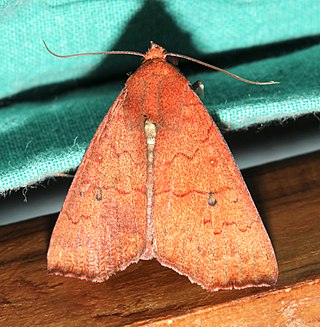
Anomis fulvida is a moth of the family Erebidae first described by Achille Guenée in 1852. It is found in Australia, African countries like Sierra Leone, South Africa, Tanzania, and Asian countries like Sri Lanka.

Anomis mesogona is a moth of the family Erebidae first described by Francis Walker in 1857. It is found in India, Sri Lanka, Somalia and Japan.
Giaura tortricoides is a moth of the family Nolidae first described by Francis Walker in 1865. It is found in Sri Lanka, Japan, Andaman Islands, Borneo, Sumatra, Flores, Sulawesi, New Guinea, Bismarck Islands and Australia.

Xanthodes transversa, the transverse moth or hibiscus caterpillar, is a moth of the family Nolidae. The species was first described by Achille Guenée in 1852. It is found in India, Sri Lanka, the Andaman Islands, the Nicobar Islands, China, Hong Kong, Vanuatu, Java, New Guinea, Japan, the Ryukyu Islands, Singapore, Indonesia and Australia.















